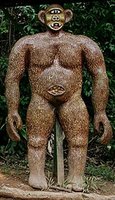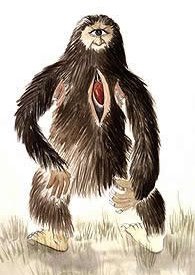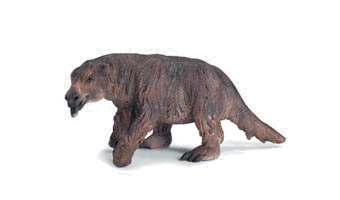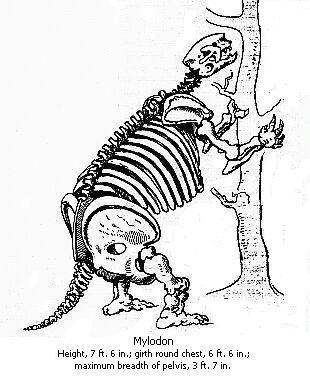Darwin’s Cryptid
Posted by: Loren Coleman on February 8th, 2009
Happy Birthday to Charles Darwin!!
His biography is straightforward. His legacy is great. Two hundred years ago he was born. Amazingly, old Charlie was born the same day as Abraham Lincoln. It looks to be a busy few days, so I thought I’d get a headstart.
Charles Robert Darwin was born on February 12, 1809, and died on April 19, 1882. Darwin, of course, is remembered as the English naturalist who realized, and first published in grand fashion, that all species of life have evolved over time from common ancestors through the process he called natural selection. You’d have to have lived under a rock to not have heard of On The Origin of the Species.
But, I am not about to talk of evolution, creationism, dinos in the Congo, or any of the hot-button topics so often associated with Darwin. (That is not to say that should stop any of you from using the comments section below to talk about those items as much as you want this week!)
I want to view Darwin through my Cryptomundo bifocals, purely cryptozoologically, around one species.
Few in cryptozoology remember that Charles Darwin is quite directly linked and responsible for a species ~ Mylodon darwinii ~ that may be the source of an ongoing cryptid investigation of interest to many of us.
Mylodon darwinii was named by Richard Owen on the basis of a nearly complete lower jaw with teeth (below), which was found by Charles Darwin. The species was found embedded in soft rock in a consolidated gravel cliff, at Punta Alta, Bahia Blanca, Argentina, by Charles Darwin during the survey expedition (“the Voyage”) of H.M.S. Beagle, 1832-36, commanded by Captain Robert Fitzroy (1805-1865), which was exploring southern South America.
Mylodon darwinii is a meduim-sized ground sloth that is more closely related to the two-toed sloths than to the three-toed sloths of today (which has been discovered due to its very good, recent DNA).
Mylodon (allegedly) became extinct at the end of the Pleistocene period, with its larger cousin, Megatherium, the giant ground sloth. Mylodon, all the standard reference tells us, is an extinct genus of giant ground sloth that lived in the Patagonia area of South America, until roughly 10,000 years ago.
Mylodon weighed about 200 kilograms (440 lb) and stood up to 3 metres (9.8 ft) tall when raised up on its hind legs. Preserved dung has shown it was a herbivore. It had very thick hide and had osteoderms within its skin for added armor. Because of this armor and its own long and sharp claws, it’s unlikely Mylodon had any natural enemies other than humans, who would have still found the skin difficult to pierce with stone projectile points.
Evidence of Darwin’s Cryptid?
At several South American sites preserved pieces of dried skin and old dung of this species have been discovered. These items are in a state of conservation that made the people who first discovered them believe they belonged to a living animal instead of an extinct species. Maybe they did.
Well-preserved samples of Mylodon remains have been discovered in the Cueva del Milodon site in Patagonia along the southern flank of Cerro Benitez in the year 1896. Associated with bones of other early Patagonian animals, these remains of Mylodon date from an era earlier than 10,000 BC.
Mylodon populations are occasionally claimed to have survived into the modern era. The discovery of fresh-looking samples of skin and dung sparked a small wave of expeditions during the early 20th century to search for a living example of the animal. The samples have reportedly since been found to be around 10,000 years old, although they look fresh, allegedly because of the extreme cold and stable conditions in the caves in which they were found.

“It is quite clear to me that the legend of the Mapinguary is based on human contact with the last of the ground sloths,” said David Oren, former director of research at the Goeldi institute in Belém, at the mouth of the Amazon River.
While some cryptozoologists, such as David Oren (as per 2007’s The New York Times), relate the reports from the Amazon rainforest of Mapinguary to Mylodon, for myself and others, the reports alone of the evidence showing the possible late survival of Mylodon and other ground sloths are enough to spark our interest.
The discovery of their subfossil remains in caverns associated with human occupation caused a few researchers to theorize that early humans built corrals when they could procure a young ground sloth, to then raise the animal to butchering size.

Bernard Heuvelmans has discussed these matters, and others have reworked parts of his discourse online.
In the 1890’s an Argentinean explorer, geographer and adventurer, Ramon Lista, was hunting in a portion of his country, known as Patagonia, when a large, unknown creature covered with long hair trotted past his party. To Lista, the creature looked like a gigantic armadillo. The party shot at the beast, but the bullets seemed to have no effect.
Professor Florentino Ameghino, a paleontologist in Argentina, heard the Lista story and began to wonder if the strange beast was a giant sloth that had somehow survived till the present day. He might not have put much stock in the Lista story if it had not been for the legends he had collected from natives in the Patagonia region about hunting such a large creature in ancient times.
The animal in the stories was nocturnal, and slept during the day in burrows it dug with its large claws. The natives also found it difficult to get their arrows to penetrate the animal’s skin.
Ameghino, furthermore, had a piece of physical evidence: A small section of apparently fresh hide found by a rancher named Eberhardt on his property in a cave in 1895. The hide was studded with small, hard, calcium nodules and would have been impervious to the teeth of many predators. It seemed likely that it would have also resisted native arrows, along with Lista’s bullets.
So sure was Ameghino this was the creature Lista had seen, he decided to name it after him: Nemoylodon listai, or “Lista’s new Mylodon.”
Expeditions to Eberhardt’s cave and other caves soon recovered additional pieces of hide. With the development of the debated Carbon-14 dating method in the twentieth century, the age of the Mylodon remains in the Eberhardt’s cave was apparantly settled. In short, the skin was estimated to be roughly 5,000 years old. Conditions in the caves may have preserved the skin, making it look fresh to the eye and fooling Ameghino.Sources, a & b
A similar situation may have occurred late into the Pleistocene in North America. The last ground sloths in North America belonging to Nothrotheriops died so recently that their discovered dung has remained undisturbed in some caves, as if it were just recently deposited. One of the skeletons, found in a lava tube (cave) at Aden Crater, adjacent to Kilbourne Hole, New Mexico, still had skin and hair preserved, and is now at the Yale Peabody Museum. The American Museum of Natural History in New York City has a sample of dung with a note attached to it that reads “deposited by Theodore Roosevelt”. The largest samples of Nothrotheriops dung can be found in the collections of the Smithsonian Museum.
I wonder what Charles Darwin would have thought of modern cryptozoology and its interest in his Mylodon darwinii? How would he have fit Bigfoot into his theories?
About Loren Coleman
Loren Coleman is one of the world’s leading cryptozoologists, some say “the” leading living cryptozoologist. Certainly, he is acknowledged as the current living American researcher and writer who has most popularized cryptozoology in the late 20th and early 21st centuries.
Starting his fieldwork and investigations in 1960, after traveling and trekking extensively in pursuit of cryptozoological mysteries, Coleman began writing to share his experiences in 1969. An honorary member of Ivan T. Sanderson’s Society for the Investigation of the Unexplained in the 1970s, Coleman has been bestowed with similar honorary memberships of the North Idaho College Cryptozoology Club in 1983, and in subsequent years, that of the British Columbia Scientific Cryptozoology Club, CryptoSafari International, and other international organizations. He was also a Life Member and Benefactor of the International Society of Cryptozoology (now-defunct).
Loren Coleman’s daily blog, as a member of the Cryptomundo Team, served as an ongoing avenue of communication for the ever-growing body of cryptozoo news from 2005 through 2013. He returned as an infrequent contributor beginning Halloween week of 2015.
Coleman is the founder in 2003, and current director of the International Cryptozoology Museum in Portland, Maine.

















Ok. I have to. I can’t help myself. “Deposited by Theodore Roosevelt”! LOL!
Ok, enough levity.
Isn’t there some speculation that the legend of Patagonian giants might have been sightings of Mylodon? Or of tallish locals wearing Mylodon pelt cloaks?
I really get nervous when crypto blogs start dabbling in politics.
The above sounds like aid and comfort to historians who have long held that Teddy Roosevelt was full of [Mylodon dung].
I think it’s highly possible, considering his career, that the bulletproof skin might be his too!
“To Lista, the creature looked like a gigantic armadillo.” Sounds more like a glyptodon.
That was funny, DWA. And Ceroill, too. Great post, Loren. And yeah, happy birthday, Mr. Darwin. Whether one agrees with all of your conclusions or not, you did irrevocably change the world forever. For better or worse. And since somehow “politics” crept in here, happy birthday to Lincoln, who was born on the same day and year as Darwin.
And a quote with some cryptozoological implications:
~ Charles Darwin, The Origin of Species
Isn’t Darwin responsible for the on-going search for evidence of the “Missing Link” too?
Depending upon whom you choose to listen to, this “Link” may also be alive a well hiding in a cold cave tonight.
Just writing to correct a tiny mistake, the Mylodon darwinii was found im gravel cliff, at Punta Alta, Bahía Blanca, ARGENTINA (not Brazil) I know that because Bahía Blanca is my hometown, haha!!
Great article Loren
*****************
Editor’s note: The original source was incorrect, sorry. The text above has been now revised. Thank you, Loren.